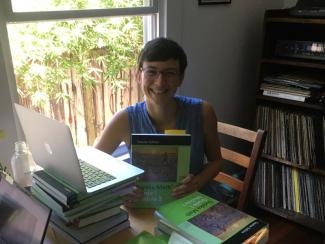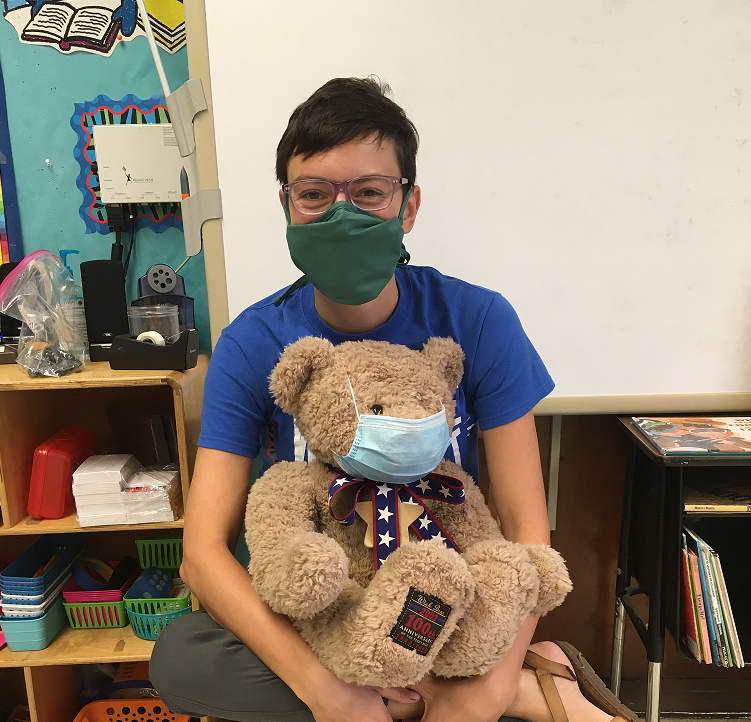
Some call it chaos; we call it Tuesday. This is the new normal.
The school year began as we expected—bumpy roads, few signposts, rows of desks not quite 3 feet apart and 6-year-olds excited to see their friends in person or on the screen. For them, first grade in a pandemic is the only first grade they know. I know what they’re missing.
Thus the teaching began, in person, with budding readers and mathematicians and scientists, soooooo happy to be in school. In Louisiana, the state standards require students to have mastered letters, letter sounds, numbers and 1-1 correspondence by the end of kindergarten. (Of course, they’d missed a quarter of their kindergarten year during our shelter-in-place orders last spring.) So that’s where we started.
Then one of the three first-grade teachers—the one teaching remotely—went out on maternity leave; the district hired a sub, placed said sub in my classroom and split her students 50-50 between the other teacher and me. Thus began our “concurrent” teaching: 18 students in my classroom and nine online. Down the hall, my co-worker and her student teacher educate a cohort about the same size as mine.
Because of the restrictions imposed by the realities of the coronavirus, this year we’re a paper-and-pencil-driven school in the lower grades, so the students at home have the same materials as the students in my class: books and workbooks. Picture this: “OK, class, we’re going to page 185 in our books.” When my in-class students can’t turn to this page in their books, I walk over to help them, but I can’t do the same for the students online. Everyone is 6 or 7; they’re developing the fine motor skills to turn and tear out workbook pages, and they only know their numbers to 100. “Hold the book up to your camera,” I say. “Turn it around so I can see the page. Good, now move it so I can see the page number.” Two minutes later, we are all together on the page. If you’ve never taught 6-year-olds, you’ll never know how long two minutes of unstructured time can be.

The New Normal in Perspective
Picture this: Two document cameras and two computers (yes, I’m fortunate to have two in my classroom when some districts have zero). I use the Chromebook to see my students on Google Meet (our school’s virtual learning platform) and I use my teacher laptop to project onto the Smartboard and share my screen for the in-person and virtual students. Since you can’t simultaneously share your screen and view participants on Google Meet, most teachers across the district are playing this multi-computer dance. We want to monitor and see our students, but we need to see what we’re teaching as well! Meanwhile, I use the two different document cameras to show the in-person students and the virtual students any physical object that I’m projecting (a workbook page, a new letter card, an example of student work, etc.). The document cameras have different frames, angles and zoom capacity, so I look at the Smartboard, the Google Meet on the Chromebook and the Google Meet on the teacher laptop to check what everyone is seeing. I zoom one camera in for the students at the back of the room to be able to see, but then I realize that I’ve now cut off part of the page for the virtual students. I try adjusting both document cameras and the worksheet just one more time. I take a deep breath. Meanwhile, I’m trying to stand in the perfect spot: 6 feet away from my in-person students, in view of the Chromebook’s camera so the virtual students can see me, and within range of two laptops, a Smartboard and my teaching supplies so that I can ... teach. On the days that I have a sub to help me, she works with the in-person students. She’s never taught with another teacher in the room and says that she’s learning a lot; we joke that she’s a student teacher now, too, and wish that she could get credit toward her degree. “Excuse me, Ms. Looney, I can’t see the big screen,” says an online student. “I know,” I say, “I’m going to log off and log back on and see if that helps. Keep working, OK?” This is the new normal.
Picture this: One student arrives at school sneezing and coughing. I write down the time of each sneeze/cough until enough time passes that I determine them to be “recurrent” symptoms. He then qualifies for me to send him to the school’s sick room. The nurse monitors him and sends him home—according to protocol, he can’t return to class to gather his supplies. In truth, we’re frightened to touch his school supplies to pack them up. We clean his desk and chair repeatedly and try to open the window a little more. “Let me know if you’re not feeling well, OK?” I say to the class. I look down at my teacher planning calendar, now filled with cough/sneeze logs and dates of who has been quarantined, medically exempted and cleared to return to school. It’s on me to make sure that we stay safe in here. I tighten my mask and take a deep breath. I find out later that my student was experiencing seasonal allergies, but that his parents won’t send him back to school only to have him repeatedly sent back home. They send me page-long notes about how much they wish he could be at school; I message them photo after photo of the workbook, and they painstakingly copy each section down so he can do his work at home. This is the new normal.
Picture this: You’re an undocumented parent who speaks little English and is, naturally, distrustful of the government. Do you go to a testing site if you suspect you or a family member has COVID-19, or do you wait it out at home and hope for the best? This is the new normal.
Picture this: You’re an essential worker without child care (for too many reasons to count here). Your job has roughly the same hours as the school day, so you’re not there to monitor or support your child with schoolwork. When the school-supplied laptop doesn’t work, your child misses instruction. If you need to leave before the child awakens, the child may not get up in time to start the school day, so the child misses instruction. The parents have told the students about the importance of being in class, so the children join the class as soon as they wake up. They stare—groggily, preciously—into the camera. “Can you take the blanket off of your head, please?” I say. “If you’re cold, go get a sweater, OK? Do you need to get a bite of breakfast to help you wake up?” This is the new normal.
Picture this: Your online students have supportive parents who check on the work, help with homework, help with tests. The parents are present, helping their kids with their schoolwork and monitoring everything you do and say. Ironically, you’ve never graded so much perfect homework or tests. This is the new normal.
Picture this: Teachers’ evaluations are based in large part on how much their students improve over the year using “student growth scores.” These scores will be skewed by several factors: parents doing their students’ schoolwork; student absenteeism; students’ lack of access to their education (for a host of reasons); the lost learning from last year. This is the new normal.
Top Distance Learning Webinars for Online and Hybrid Models

I’ve been teaching for 11 years, and in all that time I was rarely glued to one spot in my classroom. Teachers move around; we monitor and encourage our students, help them tie their shoes, wipe their noses, move them around in different learning groups, help them adjust their pencil grip. … These days I find myself standing in front of these eager learners, afraid to move from my spot, 6 feet from the front row of the future. When a student needs my help, I get only close enough to diagnose the issue, and then I scoot back to my spot. I’ve never aspired to be a “sage on the stage,” yet that’s where I find myself these days. I’m happy to be teaching in person, but it still doesn’t feel right. I can’t use 70 percent of what makes me a good teacher because of social distancing restrictions. I am my school’s 2020-21 Teacher of the Year, but I feel like a mediocre version of my teaching self. “You’re doing the best with what you have,” my friends encourage. But I can’t shake my feelings of frustration and limitation. “We don’t want it to be the weekend,” my students say. “We want it to be school every day.”
Yes, it’s a chaotic, challenging, daunting, uncertain, cringe-inducing tightrope walk. Yes, we are all swamped with fatigue. But it’s really just a new normal Tuesday.

Rosamund Looney has been teaching at public and charter elementary schools in the greater New Orleans area for 11 years. She currently teaches first grade, and has spent most of her teaching career in kindergarten and first grade. She graduated from the Jefferson Federation of Teachers’ Teacher Leaders Program four years ago, and has been the program’s facilitator for the past three years. She serves on JFT's executive council and as a building representative at her school and was recently selected as the 2020-21 Teacher of the Year for William Hart Elementary.
